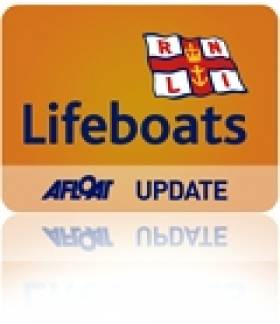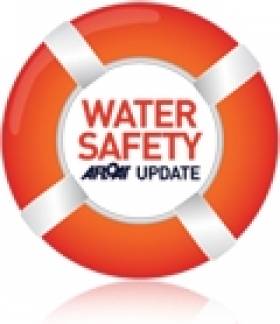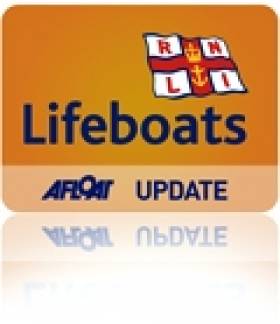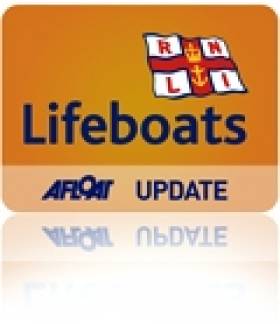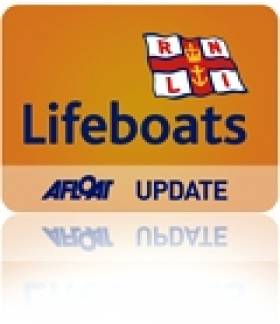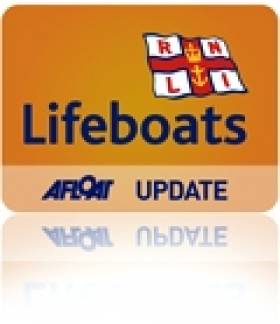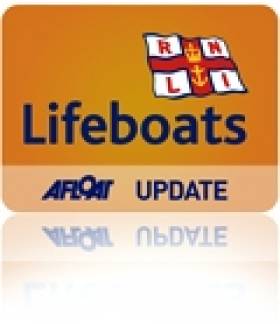Displaying items by tag: Ballycotton
Ballycotton Lifeboat In Search for Missing Person off East Cork
#RNLI – The emergency services were alerted shortly before 5pm on Saturday afternoon, 10 August, that an elderly person might be missing at Garryvoe Beach. The Ballycotton RNLI lifeboat was asked to be on standby while the area was searched.
At 5:10pm the RNLI lifeboat crew pagers in Ballycotton were activated and the Ballycotton lifeboat was requested to launch to help in the search. Also requested to join in the search were the Ballycotton Coast Guard unit and the Waterford based Coast Guard helicopter, Rescue 117.
At 5:15pm the RNLI lifeboat boarding boat dropped the all weather lifeboat crew aboard the Austin Lidbury. The boarding boat then proceeded across Ballycotton Bay to carry out a search of the water close to the shore at Garryvoe. The all weather RNLI lifeboat launched and carried out a search of the deeper water in Ballycotton Bay.
At 6:35pm it was reported that the elderly person was safe and well and the search was called off.
Rosslare RNLI Praises Emergency Caller Despite False Alarm
#WaterSafety - Rosslare RNLI has given credit to the quick-thinking member of the public who raised the alarm over what they believed to be a swimmer in difficulty - even though the call-out turned out to be a false alarm.
Lifeboats from Rosslare Harbour and Wexford RNLI were involved in the sea search on Friday evening (19 July) after a swimmer was reported to be in difficulty off Curracloe beach in Co Wexford.
The Irish Coast Guard helicopter Rescue 117 and two local fishing vessels were also involved in the search, which was stood down after an hour and 45 minutes upon coastguard request as no one was reported missing.
Speaking after the call-out, Rosslare RNLI deputy launching authority Dave Maloney said: "The member of the public who raised the alarm this evening deserves credit for doing so."
He added: "We would always encourage the public to alert the emergency services if they see anyone they believe to be in trouble or any signs of danger."
The message is particularly important in a fortnight that has seen a shocking 10 drownings around the island of Ireland - resulting in a big rise in emergency call-outs over the 2012 mid-summer period.
Elsewhere on the same day, the Ballycotton RNLI lifeboat was requested to help search the water off Ballinamona Strand in Ballycotton Bay, Co Cork, for a missing five-year-old girl.
The little girl was playing on the strand when her family lost sight of her. Emergency services were alerted and a search of the area commenced, but thankfully a short while later the little girl was located safe and well.
In other water safety news, the Irish Coast Guard has issued a public appeal for help locating a training mannequin that was lost in Galway Bay during an exercise off Blackhead in North Clare last week.
The Connacht Tribune reports that five coastguard mannequins were placed in the water to acts as people who jumped overboard from a ship fire - but only four were recovered afterwards.
Injured Yachtsman Brought Ashore By Ballycotton Lifeboat
#lifeboat – Ballycotton RNLI lifeboat launched this afternoon, Sunday, 21 July, at 17:10 to assist an injured person on board a 42 ft yacht 6 miles south west of Ballycotton.
On arrival at the casualty the injured person was transferred to the RNLI lifeboat and taken to Ballycotton.
An ambulance was requested to meet the RNLI lifeboat on Ballycotton pier. The lifeboat with the casualty on board arrived at Ballycotton at 17:55 where he was assessed by medical personnel and taken to Cork University Hospital for treatment.
Having escorted the casualty ashore the Ballycotton lifeboat rejoined the 42 foot yacht with two persons still on board and escorted it safely to harbour.
Ballycotton Lifeboat Tows 30-Footer to Safety
#rnli – Ballycotton lifeboat launched at 17:15 this evening to a 30 ft Irish registered vessel with mechanical difficulties 12 miles east of Ballycotton.
The vessel with two persons on board ran into difficulties and sought assistance. The Ballycotton lifeboat, Austin Lidbury, arrived on scene at 17:50.
The situation was assessed and a tow line was established. The vessel was taken under tow to Ballycotton where it was safely secured alongside the pier wall at 20:00.
UK Lone Sailor Rescued 38 Miles off Cork Coast
#rnli – Mine Head Coast Guard received a call for assistance at 3:30am this morning from a lone sailor on passage from the UK.
Ballycotton lifeboat launched at 3:45am and proceeded to the known position of the 6.5 metre vessel, which was approx. 38 miles east south east of Ballycotton off the East Cork coast.
The yacht was still under steam and the RNLI lifeboat reached the vessel at 5:25am.
Two crew members were placed aboard the yacht and the yachtsman was transferred to the Ballycotton RNLI lifeboat where his condition was assessed.
It was decided to have the casualty air lifted and the Waterford based Coast Guard helicopter, Rescue 117, has been requested to launch.
The helicopter was expected to reach the Ballycotton lifeboat at approx. 07:00am.
Update at 0740
The helicopter rendezvoused with Ballycotton lifeboat at 06:50am, approx. 25 miles off Ballycotton. The casualty was air lifted to Waterford airport where an ambulance has been requested for 07:30am. The yacht is sailing under its own steam, with two lifeboat crew members aboard and the Ballycotton lifeboat accompanying it.
Cork Lifeboat Rescues Sailor from Capsized Sailing Dinghy
#lifeboat – A pan pan message was sent out and the Ballycotton lifeboat crew pagers were activated this afternoon for a capsized sailing dinghy.
The alert was for a capsized sailing dinghy one mile north east of Ballycotton lighthouse with one person on board. The lifeboat crew assembled at the lifeboat station and the Ballycotton lifeboat, Austin Lidbury, was launched.
The lone sailor was located within minutes sitting on the hull of the upturned 14 foot dinghy. He was wearing a dry suit which helped to keep him warm while he waited for help to arrive. He was taken on board the Ballycotton lifeboat. Attempts were made to right the dinghy but these were unsuccessful. It was decided to take the dingy under tow into a more sheltered position in Ballycotton bay.
The Ballycotton lifeboat boarding boat joined the all weather lifeboat and a further attempt was made to right the sailing dinghy, which was successful. The dinghy was bailed out and towed into Ballycotton harbour where it was placed on moorings.
Loan Fisherman Fouls Prop off East Cork Coast
#rnli –Yesterday afternoon, a lone fisherman contacted the emergency services seeking assistance when his propeller became fouled 3 miles south of Ballycotton lighthouse off the East Cork coast.
The Ballycotton lifeboat, Austin Lidbury, launched at 16:20 and proceeded to the casualty. When they arrived on scene it was found the 20 foot fishing vessel was still attached to the net and it was necessary to cut it free. The vessel was taken under tow to Ballycotton harbour where it was safely secured alongside the pier wall at 17:30.
Ballycotton Lifeboat Assists Broken Down RIB
#rnli – The annual family fun day was held on Ballycotton pier to raise funds for Ballycotton lifeboat yesterday on bank holiday Sunday afternoon. At 12:30 the lifeboat station received a call from a rib with engine failure east of Ballycotton lighthouse and requesting assistance. The lifeboat crew abandoned their posts on Ballycotton pier and proceeded to the all weather lifeboat moored in the harbour. The Ballycotton lifeboat, Austin Lidbury, proceeded east of the lighthouse and reached the rib with four persons on board. The pleasure craft was taken under tow to Ballycotton harbour, where they were closely observed by visitors on the pier attending the fundraising activities.
The afternoon was a hit with the many visitors being able to observe a live rescue. Among the afternoon's activities was "Rock the Boat" which took place at 3:00pm, with in excess of 100 people taking part to fulfil a condition of a sponsor who offered €100 if 100 people or more took part. A short video clip of this is available to view on the Ballycotton Lifeboat website www.ballycottonlifeboat.org. At 3:45pm the Waterford based Coast Guard helicopter did a fly-by over the pier. Conditions were not suitable to demonstrate a lift of a person from the Ballycotton lifeboat which was going through manoeuvres in Ballycotton Bay.
At 5pm the visitors moved from the pier to the village to continue the fundraising activities with a wet t-shirt competition in the Blackbird. The event rounded up a weekend of fundraising events for the Ballycotton RNLI lifeboat, which included a football competition on Thursday evening, a table quiz in the Schooner Bar on Friday and a family treasure hunt and Pitch "n" Putt competition on bank holiday Saturday. The organisers and volunteer crew appreciated the support they received during the long weekend of fundraising events from both sponsors and supporters.
Anglers Towed to Safety by Ballycotton Lifeboat
#rnli – Ballycotton lifeboat rescued a pleasure craft one mile south east of Capel Island, off the East Cork coast yesterday. The Coastguard received a call for assistance shortly after 1500 and requested the RNLI lifeboat to launch. The 25–foot vessel with five anglers aboard were experiencing mechanical difficulties and were in need of assistance.
Weather conditions in the area were poor at the time with the winds blowing force 5 / 6 and poor visibility. When the Ballycotton RNLI lifeboat arrived at 1600 they established a towline and took the vessel under tow to Ballycotton, arriving at 1800. The pleasure craft was safely secured alongside the pier wall.
Report into Death of Crab Fisherman Prompts Call for Review of Stability Standards
#MCIB - The Marine Casualty Investigation Board (MCIB) has recommended a ministerial review of stability standards for fishing vessels following its report into the death of a crab fisherman off Co Cork in January last year.
Gerry Hegarty drowned after a wave struck the crab boat Carraig An Iasc, which was fully loaded with crab pots at the time, causing it to capsize and sending its two-man crew into the water.
Hegarty, who was not wearing a personal flotation device (PFD) or other buoyancy aid, got into difficulty while attempting to swim ashore with his crewmate and skipper James Fitzgerald, who subsequently raised the alarm.
Lifeboats from Ballycotton and Crosshaven, as well as Irish Coast Guard helicopter Rescue 117, were tasked to the incident. Divers from Naval Service vessel LE Emer located the sunken crab boat but no body was found.
A coastguard search of the area continued over a number of days without success. Hegarty's body was eventually recovered on 17 February 2011 at Ringabella Strand in Co Cork.
The MCIB found it probable that the Carraig An Iasc encountered wind or wave action or a combination of both that caused the vessel to heel to an angle beyond which it was able to recover from its loaded condition. The vessel's Code of Practice Declaration of Compliance was valid until 15 July 2013.
The board noted that there have been "a number of incidents caused by overloading boats thus effecting stability", and recommended that the Minister for Transport reviews and revises the stability standards in the current Code of Practice to improve these standards.
It was also recommended that a safety notice be issued to all skippers and owners in the fishing fleet reminding them of their legal responsibility to ensure that all their crew wear PFDs or lifejackets while on deck.
The full report is available to download as a PDF from the MCIB website HERE.
- Crosshaven
- Cork
- Safety
- Fishing
- Ballycotton
- Lifejacket
- Lifeboat
- Marine Casualty Investigation Board
- Coastguard
- Irish Coast Guard
- Skipper
- naval service
- helicopter
- MCIB
- Rescue 117
- personal flotation device
- Minister for Transport
- LE Emer
- standards
- drowned
- crab fishing
- Carraig An Iasc
- Gerry Hegarty
- James Fitzgerald
- PFD
- Ringabella Strand
- Code of Practice
- stability
- overloading


























